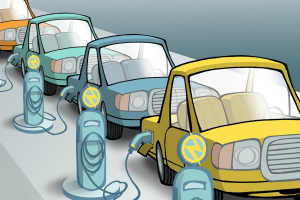Is electric transportation a reality, or is it plugged into science fiction? Today a mere 300,000 of the 250 million automobiles on U.S. highways can be plugged into a charger and propelled by electricity. The internal combustion engine dominates.
But history reveals that a future dominated by electric vehicles is entirely possible. The marriage of transportation and electricity predates Henry Ford and the rise of gasoline-powered automobiles. As early as the 1890s, Indiana power generators helped streetcars replace the horse and buggy for local transportation, and within a few decades electric railways known as interurbans connected cities and towns in the Hoosier State. Public Service Indiana, the predecessor of Duke Energy Indiana, owes its beginning in part to the need to transport passengers to and from places such as New Albany, Kokomo, and Indianapolis.
“The original business model of some electric utilities in the United States was based on providing electricity to the electrified railroads that existed 100 years ago,” said Mike Rowand, director of technology development at Duke Energy. Only later did their core business expand to delivering power to homes and businesses.
With that in mind, there’s evidence today that transportation is moving back to an electrified future. Dan Bowermaster, EPRI’s electric transportation program manager, points out that plug-in hybrid vehicles are selling at more than double the rate that non-plug-in hybrids did a decade ago.
Electric Renaissance on Wheels?
As electric transportation enters what appears to be a renaissance, EPRI Journal examines its prospects in 2050. Through more than a dozen interviews with utilities, automakers, and EPRI experts, we gathered insights on how electric vehicles could affect emissions, the grid, utility business models, the driver experience, and more. Two common themes emerged in these perspectives: Many electric vehicles are on their way, and thank goodness they are.
“I think there will be some huge changes in the transportation sector, all for the better,” said Bowermaster. For one, the prevalence of electric vehicles will drastically reduce or eliminate trips to gas stations. “For most drivers of the future, 70% to 90% of fueling will be done at home or work,” said Bowermaster.
Mid-century car owners will be able to drive inexpensively. Even though gasoline prices are currently low, few expect that to last for decades. Indeed, the economics of fueling electric vehicles have long been superior to gas fueling and likely will become more so. Michael Tinskey, global director of electrification and infrastructure at the Ford Motor Company, points out that the gallon-of-gasoline equivalent for electricity prices has been cheaper since the middle of the 20th century. “Where electricity used to be eight times more expensive than gas, now it’s one quarter the cost or less. We believe that trend will continue,” said Tinskey.
Among those interviewed, broad agreement emerged that electrification will be standard by mid-century. “I could see every vehicle having a battery that does some or all the work,” said Britta Gross, director of advanced vehicle commercialization policy at General Motors.
Though questions remain on what the future of electrified transportation will look like, we know this: It’s going to be an interesting ride.
Key EPRI Technical Experts:
Dan Bowermaster
For more information, contact techexpert@eprijournal.com.
Artwork by Kirk Anderson. “Dollars per Gallon Equivalent” chart by Craig Diskowski/Edge Design.




